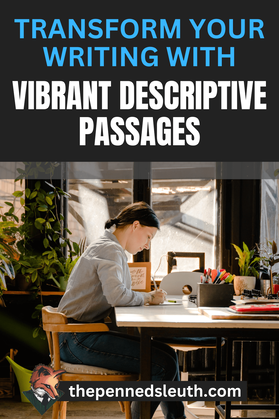Latest Writing Video! |
|
Descriptive passages are a great way to bring your words to life and transport your reader into the world of your story. In this blog post, I will go through some tips and techniques for writing descriptive passages that will make your writing stand out. There’s also a fun practice exercise for you to test out these techniques at the end. Whether you’re a beginner writer or just looking to sharpen your skills, this post has something for you. So let’s dive in and get descriptive! Pin for Later!Tips for Writing Descriptive PassagesFirst, some tips and advice for writing descriptive passages. Not every tip is usable depending on your style of writing, but every one of them can help you create a vibrant scene that immerses the reader.
Examples of Effective Descriptive WritingTo give you a better idea of how these techniques can be used in practice, let’s take a look at some examples of effective descriptive writing from popular novels: Take this passage from The Lord of the Rings: The Fellowship of the Ring by J.R.R. Tolkien: “The wide world was all about them: the long white road behind, the sparkling River ahead, and all the while fields and hills, folds of the land and trees, and in the distance the secrets of the untold countries. The air was very clear and the sky was blue, blue as if it had been enameled, and the happy sun was beginning to climb the sky, sending out beams all around, and drinking the dew.” In this passage, Tolkien uses sensory details and personification, such as the “sparkling river” or the “happy sun” “drinking the dew”. These descriptives create a vivid and immersive depiction of the setting. Tolkien also emphasizes the adventurous tone of the story with the “long white road” and “the secrets of the untold countries.” Another example comes from J.K. Rowling’s Harry Potter and the Sorcerer’s Stone. When Harry first enters the wizarding world, Rowling uses descriptive language to bring the magical setting to life: “The first sign that they were entering a strange world was the sudden appearance of a huge, hand-painted sign, pointing the way to the Hogwarts Express. Harry could make out the words, painted in bright red letters: Hogwarts School of Witchcraft and Wizardry. He stared at the sign, feeling a warmth spread through him that had nothing to do with the sun.” More descriptions that help create a vivid scene. The entire paragraph is centered on this scene and Harry’s reaction to it. From the sensory details of “bright red letters” and “hand-painted” to the emotional reaction of Harry. Here is another passage from C.S. Lewis’s The Lion, the Witch, and the Wardrobe: “It was the sort of house that you never seem to come to the end of, and it was full of unexpected places. The first few doors they tried led only into spare bedrooms, as everyone had expected that they would; but soon they came to a very long room full of pictures and there they found a suit of armor; and after that was a room all hung with green, with a harp in the corner. And then there was a room full of books, more books than anyone could have imagined.” In this passage, Lewis describes the contents of the house, filling it with curious oddities, but paying close attention to the ones that stuck out rather than simply telling the reader it was filled with oddities. Conversely, Lewis contradicts these specifics with magical abstracts such as “never seem to come to the end of” and “more books than anyone could have imagined.” Even though Lewis uses abstracts, he shapes them with specifics. These are just a few examples, but you can find excellent descriptive writing in all sorts of works of literature and popular media. Take some time to explore and see what techniques and approaches catch your eye. Fun Prompts/Exercises for PracticeNow that you’ve seen some examples and gotten some tips on writing descriptive passages it's time to try your hand at it! Here are a few prompts to get you started:
Remember, the key to writing effective descriptive passages is to present the necessary information in an engaging, vivid way. You don’t want the reader to present details that don’t serve the story in some way, be it defining the setting or characters, or progressing the plot. If you want to share your writing with others, feel free to post it in the comments or share it on social media. ConclusionI hope you enjoyed this simple overview of descriptive writing, but there is always more to learn. I have an entire course dedicated to descriptive writing on my Writer’s Workshop. We go through more examples and actionable steps to make your descriptions more impactful and immersive.
If you want to take your writing to the next level, I recommend checking out my Writer’s Workshop here! By joining the workshop, you not only get access to that course, but every single one of my writing courses and all my future writing courses as well. With one payment you get lifetime access to an ever-growing library of premium writing content. Of course, if you want to see my teaching methods before signing up, you can enroll in one of my free writing courses here. I hope you enjoyed this post and as always, Good day, goodnight, and happy writing!
0 Comments
Leave a Reply. |







